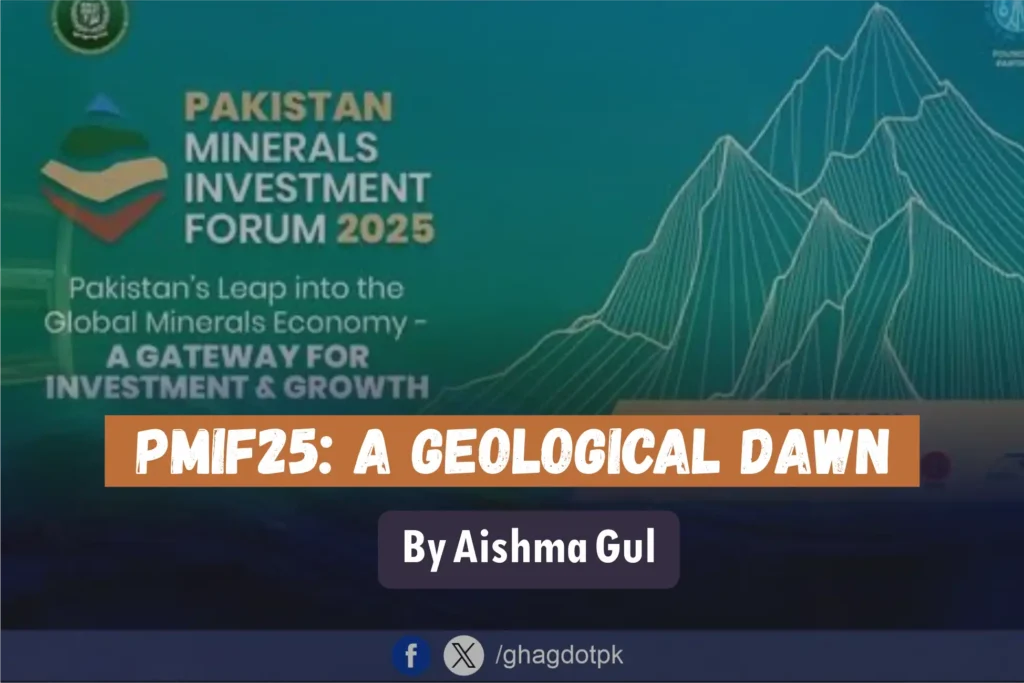By Aishma Gul
“Minerals may be hidden underground, but their impact on economic growth is crystal clear.”
Pakistan Minerals Investment Forum 2025: Unlocking a $1 Trillion Geological Treasure
As global demand for critical minerals soars, Pakistan positions itself as the next frontier for metals and minerals exploration, particularly in regions like Khyber Pakhtunkhwa and Balochistan. The Pakistan Minerals Investment Forum 2025 (PMIF25), hosted at Islamabad’s Jinnah Convention Centre, represents a game-changing milestone for the minerals sector of the country. Pakistan’s mineral wealth, estimated at over $1 trillion and including more than 92 known minerals (with only 52 exploited so far), is still largely untapped. Supported by SIFC and international firms including Barrick Gold and Rio Tinto, the summit is a key step to transforming Pakistan into a mining hub, remedying decades of under-investment.
Why PMIF25 Matters: A Shift in Strategy
Despite possessing the world’s second-largest salt reserves and fifth-largest copper-gold deposits, Pakistan’s mineral sector contributes only 3.2% to GDP and 0.1% to world exports.
The PMIF25 aims to counter this paradox by:
-
Launching the National Minerals Harmonization Framework 2025, streamlining provincial regulations, offering tax incentives, and fast-tracking licenses.
-
Highlighting high-potential assets such as Reko Diq (5.9bn tons of copper-gold resources) and Saindak.
-
Attracting US, Saudi, and other delegations, including Eric Meyer, a senior US official focused on critical minerals.
Key initiatives include:
– Regulatory Reforms: Tax concession, zero-duty machinery imports, investor-friendly ownership rules
– National Coordination: The Single Window facility managed by the Special Investment Facilitation Council (SIFC) ensures a streamlined process.
Revealing the Mineral Resources: Regional Perspectives
Pakistan’s diverse geography is home to an array of minerals, each with its unique applications and international market demand. The following section provides an overview of the primary mineral regions, emphasizing key resources, their applications, and economic importance.
Balochistan: Resource Hub
With 55% of the national outcrop area, Balochistan is a reservoir of metallic & non-metallic minerals.
Copper and Gold (Rekodak & Sindak):
With 6.5 billion tons of copper and 50 million ounces of gold, these deposits are vital for electronics, industrial manufacturing, and infrastructure projects. Their high purity and large volume make them attractive targets for global markets.
Chromite and Barite:
Balochistan is a top producer of chromite — a mineral that is key to making stainless steel — and barite, a widely used component of drilling fluids that are used to help extract oil and gas. Demand for these minerals both in Australia and internationally remains strong, particularly in the metallurgical and energy sectors.
Non-Metallic Assets:
The province has large deposits of onyx, marble, granite, coal, sulfur, gypsum, and anhydrite, as well. Marble and granite from Balochistan are highly valued in the construction and decorative industries worldwide, whereas coal is key to power generation.
Khyber Pakhtunkhwa: Hidden Riches
KP has a diverse mineral wealth, divided into dimension stones, gemstones, industrial rocks, fuel minerals, and metallic minerals.
Gemstones and Dimension Stone
– Swat: Among the world’s finest; used in luxury jewellery. Swat’s emeralds rival Colombia’s in quality.
– Aquamarine, Sapphires, and Topaz: Areas like Chitral (aquamarine), Timergara (corundum), and Katlang (topaz) contribute to KP’s reputation for precious stones.
– Marble and Granite: KP has 3 billion tons of granite and large reserves of marble, especially in the Malakand district and Khyber, Mohmand, and Bajaur regions. With Pakistan hosting about 2,900 million tons of marble—roughly 99% of the country’s reserves—this sector supports construction, export, and ornamental markets worldwide.
Industrial and Fuel Minerals:
– Limestone and Coal: Vital for cement production and energy generation, KP’s deposits serve both local industries and international trade.
– Metallic Minerals: The region is emerging as a significant source of copper and base metals, with ongoing exploration revealing further potential.
– Geological Diversity: KP’s geography, particularly the Hindukush-Karakoram block and Kohistan batholith, is endowed with antimony, arsenic, polymetallic sulfides, and myriad precious and semi-precious stones. These deposits — from rock gold to molybdenum— are important for modern electronics, renewable energy components, and high-tech applications.
Sindh And Punjab: Complementary Contributions
– Coal and Granite: The deposits of 185 billion tons of coal and 26 billion tons of granite exist in Sindh. The presence of five major cement plants bolsters its role in the construction sector. These resources not only meet domestic demand but also position Sindh as a key export region.
– Salt & Building Materials: Punjab has the 2nd largest Khewra salt mine in the world, a vast amount of limestone reserves, and deposits of iron ore and silica sand. These materials play a crucial role in construction, manufacturing, and several industrial processes.
Gilgit-Baltistan and Azad Kashmir: In addition, these regions have significant potential as a source of important gemstones, gold in rock, antimony, and molybdenum, contributing to the country’s diversified mineral base.
Pakistan Minerals Investment Forum 2025 is not just another conference; it is like a lifeline for Balochistan and Khyber Pakhtunkhwa (KP), two provinces beset by underdevelopment and rich in mineral wealth. PMIF25 is an enabler in these regions: a unique alignment of global interest, policy reform, and infrastructure readiness to turn geological riches into equitable growth.
Strategic Benefits for Balochistan
With surging global demand for copper, powered largely by the fast-growing electric vehicles (EVs) and renewable energy sectors, Balochistan’s potential deposits of some 5.9 billion tons of copper could help propel Pakistan into the ranks of the top 10 global copper producers by 2030. As great economies accelerate their transition to cleaner technologies, high-quality copper from Balochistan could prove a key input, with accompanying foreign investment and export revenues.
Additionally, the world stainless steel sector is expected to increase by approximately 5% per year (World Steel Association). Balochistan has a sizeable reserve of chromite, which presents a huge opportunity: if chromite were processed into higher-order products instead of being sent raw or abroad, the value of exports from the province could triple. This value-added method would provide benefits for markets in China and Turkey, two major consumers of stainless steel, and in turn, bolster Pakistan’s position in the global mineral supply chain.
Opportunities for Khyber Pakhtunkhwa
As Balochistan particularly dazzles with its immense copper and chromite deposits, KP’s mineral landscape holds valuable transformative potential, manifesting the trends of global markets. New findings in KP have revealed copper belts are strategic to satisfying the increasing need for electric vehicle (EV) components, with significant deposits located in the Chitral area.
Moreover, KP possesses about 99% of the marble reserves of Pakistan, thus making it a strategic player in the global construction & decorative sector. But in KP, extraction techniques remain archaic, causing wastage of up to 60% of marble blocks. Modernization of these methods will be not only efficient in terms of resource use but also can greatly increase the exported value of processed marble products. With modernized technology and facilities, KP can turn its wealth of underutilized marble into a lucrative, value-added industry.
The Minerals Investment Forum 2025 can also help KP diversify its economy outside of these specific sectors. Better infrastructure investments—including improving transport networks and setting up modern processing centres—along with global cooperation and technology transfer, will lead to efficiencies and employment.
To sum up, the Pakistan Minerals Investment Forum 2025 is set to create a dynamic economic ripple effect on the mining world by attracting significant investments, modernizing its practices, and in doing so, drawing in a massive transfer of technology. This will create thousands of direct & indirect jobs & local industries will be boosted in terms of value addition and regulatory reforms. Enhancing the region’s infrastructure and policy framework, the summit is set to benefit regional economies, especially in the resource-rich provinces of KP and Balochistan, while also establishing Pakistan as a competitive player in the global mining trade.
(April 9th, 2025)






